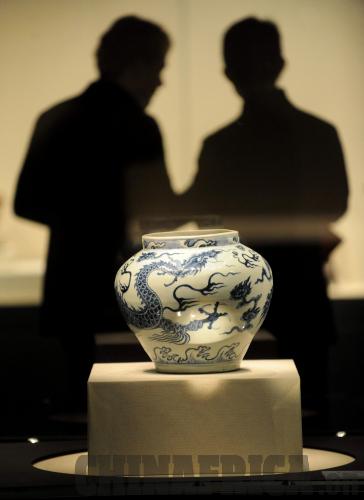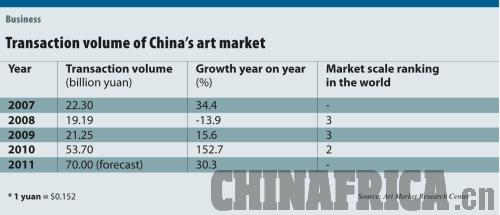|
 |
|
IN DEMAND: Millions are changing hands as Chinese artwork lights up auctions (LUO XIAOGUANG) |
Back in the 1980s when China's art auction market was waking up from decades of slumber, anyone would have found it hard to imagine the pinnacle that the market achieved last November.
A 200-year-old royal vase, dated from the Emperor Qianlong period (1735-96) of the Qing Dynasty (1644-1911), was sold at 53.1 million pounds ($85.49 million) to a domestic buyer at Bainbridge's, a small auction house in Ruislip, northwest London. The price stood close to that of the most expensive art piece ever sold at an auction worldwide, Picasso's Nude, Green Leaves and Bust, and hit the newest record in China's art auction history.
However, the Qianlong vase only represents a small part of the country's annual art auction performance.
In 2010, the transaction volume of China's art auction market jumped by more than 150 percent from the previous year, reaching 57.3 billion yuan ($8.72 billion). In autumn alone, which is also the traditional peak season for the art market, it saw a transaction volume of 37.2 billion yuan ($5.66 billion), which was 1.65 folds of the whole year's figure in 2009.

Making history
Observers have started to call 2010 the "first year of a historical era" for China's art auction market. They based this judgment on the development of the market in the last six decades.
Due to various reasons, the country's art auction market remained stagnant from the 1950s through to the 1970s, leading to a slow revival from the late 1980s.
In 1995, a Chinese traditional painting that dated from the Northern Song Dynasty (960-1127) was auctioned at 19.8 million yuan ($3.01 million), marking the first art piece sold for over 10 million yuan ($1.52 million) in China.
After that, the art auction market started to move at an accelerated pace, with the market witnessing the appearance of the first art item sold for 100 million yuan ($15.2 million) 14 years later, and the number quintupling the following year.
Xi Mu, Secretary General of the China Gallery Association and author of the white paper "China's Art Market 2010", believes that the country's art market is going through a fundamental transformation.
"Specifically speaking, the money involved in the market is shifting from individual funds to institutional investment and business capital," said Xi.
In its long history, China has always kept a strong tradition of art collection. Data revealed by the China Economic Weekly magazine showed that the country is host to more than 70 million collectors, including groups and individuals.
By learning appreciation skills through specialized societies, TV and radio programs, special columns in newspapers and magazines, or even Internet forums, millions of collectors have become more professional in appreciation and collection of artworks in the country.
Lu Jingqing, General Manager of Xiling Yinshe Auction Co. Ltd., one of the most influential auction houses in China, believes that a general rise in the quality of life now allows more Chinese to appreciate the things that bring them joy.
"Art's eternal values lie in that people can get spiritual satisfaction from it," Lu added.
|